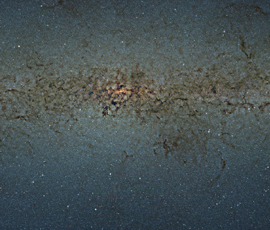
VISTA image
The image is so large that, if printed with the resolution of the average book, it would be nine metres long and seven metres tall. The huge dataset contains ten times more stars than previous studies and is a major step forward for the understanding of our home galaxy, the Milky Way.
"This gigantic image is an impressive testament to the quality of the images being taken at the VISTA telescope which UK astronomers and engineers conceived, designed and built for delivery to its home at the European Southern Observatory site in Chile's Atacama desert", said Professor Jim Emerson from the School of Physics and Astronomy. "The unprecedented detail on numbers, types, and locations of stars towards the centre of our Galaxy is giving us exciting new tools to test competing models for how our galaxy is really structured and came to be as it is”, he added.
Queen Mary, University of London leads the VISTA consortium and is one of two UK institutions named on the paper. The other is the University of Hertfordshire.
Most spiral galaxies, including our home galaxy, the Milky Way, have a large concentration of ancient stars surrounding the centre, that astronomers call the bulge. Understanding the formation and evolution of the Milky Way’s bulge is vital for understanding the galaxy as a whole.
The team of astronomers have used data from one of six public surveys carried out with VISTA, the VISTA Variables in the Via Lactea programme (VVV), to create a monumental 108,200 by 81,500 pixel colour image containing nearly nine billion pixels, one of the biggest astronomical images ever produced. The processing of VISTA's raw images into the astronomically useful calibrated images which were then used to construct this image was carried out at the Cambridge Astronomical Survey Unit, a part of the UK's VISTA Data Flow System.
The new colour–magnitude diagram of the bulge contains a treasure trove of information about the structure and content of the Milky Way. One interesting result is the large number of faint red dwarf stars.
For more information: http://www.stfc.ac.uk/News%20and%20Events/42932.aspx



